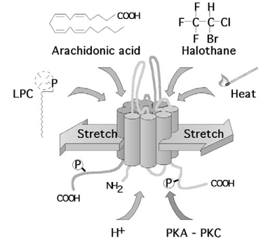Figure 1. TREK channels are opened by a variety of physical (stretch, acidosis and heat) and chemical stimuli (polyunsaturated fatty acids, lysophospholipids and volatile anaesthetics) and are regulated by phosphorylation.

4TMS/2P subunits are believed to dimerize to form functional K+ channels. TREK channels and their functional homologue, the Aplysia S-type K+ channel, have been implicated in learning and memory. At the pathophysiological level, cell swelling, intracellular acidosis, along with the release of cellular lipids, will contribute to the opening of TREK and TRAAK channels during brain ischaemia and could represent an important neuroprotective switch.
